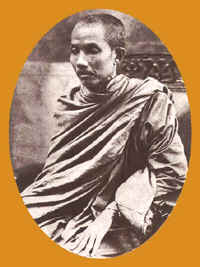Vajirananavarorasa
| Somdet Phra Maha Samana Chao Krom Phraya Vajirañāṇavarorasa |
|
|---|---|
 |
|
| Religion | Buddhism |
| School | Theravada, Dhammayuttika Nikaya |
| Dharma names | Manussanāga |
| Personal | |
| Nationality | Thai |
| Born |
12 April 1860 Grand Palace, Bangkok, Thailand |
| Died | August 2, 1921 (aged 61) Wat Bowonniwet Vihara, Bangkok, Thailand |
| Senior posting | |
| Title | Supreme Patriarch of Siam |
| Predecessor | Somdet Phra Sangharaja (Sa Pussadeva) |
| Successor | Krom Luang Jinavorn Sirivaddhana |
Vajirananavarorasa (also spelled Wachirayan, Watchirayanawarorot, correct Pali spelling: Vajirañāṇavarorasa, Thai: วชิรญาณวโรรส, full title Somdet Phramahasamanachao Kromphraya Vajirananavarorasa สมเด็จพระมหาสมณเจ้ากรมพระยาวชิรญาณวโรรส ) (12 April 1860, Bangkok, Thailand - 2 August 1921, Bangkok, Thailand) was the 10th Supreme Patriarch of Thailand from 1910 to 1921. He helped to institutionalize Thai Buddhism.
Vajirañana was the 47th child of King Mongkut and was destined to become "the leading intellectual of his generation in Siam", in the words of the Thai historian David K. Wyatt (cited in Reynolds 1979:xiii). His royal name was Prince Manuṣyanāgamānob (พระองค์เจ้ามนุษยนาคมานพ) ('he who is a nāga among men'). Vajirañāṇavarorasa is the name he received on a gold nameplate together with the krommamuen rank on 16 March 1882.
Vajirañana was born in the Grand Palace as the 4th child of Phae, one of King Mongkut's concubines. She died after giving birth to her fifth child, a daughter, when he was one year old. He was then fostered by a maternal relative (Princess Varaseṭhasutā, "Putrī", daughter of King Rama III) and her mother (a royal concubine named Samaśakti or "Ueng").
In the palace he learned the Siamese alphabet by a woman ("Nok Panakngan"). A nobleman (Phraya Pariyatidharrmadhātā, "Piam", then called Luang Rājābhirama), deputy head of the Royal Pundits Department, came to the Palace to teach the seven- or eight-year-old Vajirañana (and other princes) the Khmer script used to inscribe religious texts (in Pali). With a teacher who was official at the Outer Court, Vajirañana studied Padamālā (i.e. Pali grammar), the Dhammapada commentary etc. until 1868. When his elder brother, Prince Brahmavarānurakṣa, ordained as a novice, Vajirañana was allowed to live with him in Wat Pavaraniveśa for some while. There he occasionally studied Pali scripture with Phra Pariyatidharrmadhātā ("Chang", then Luang Śrīvaravohāra), one of the four section chiefs in the Royal Pundits Department, who taught monks and novices at the monastery.
...
Wikipedia
